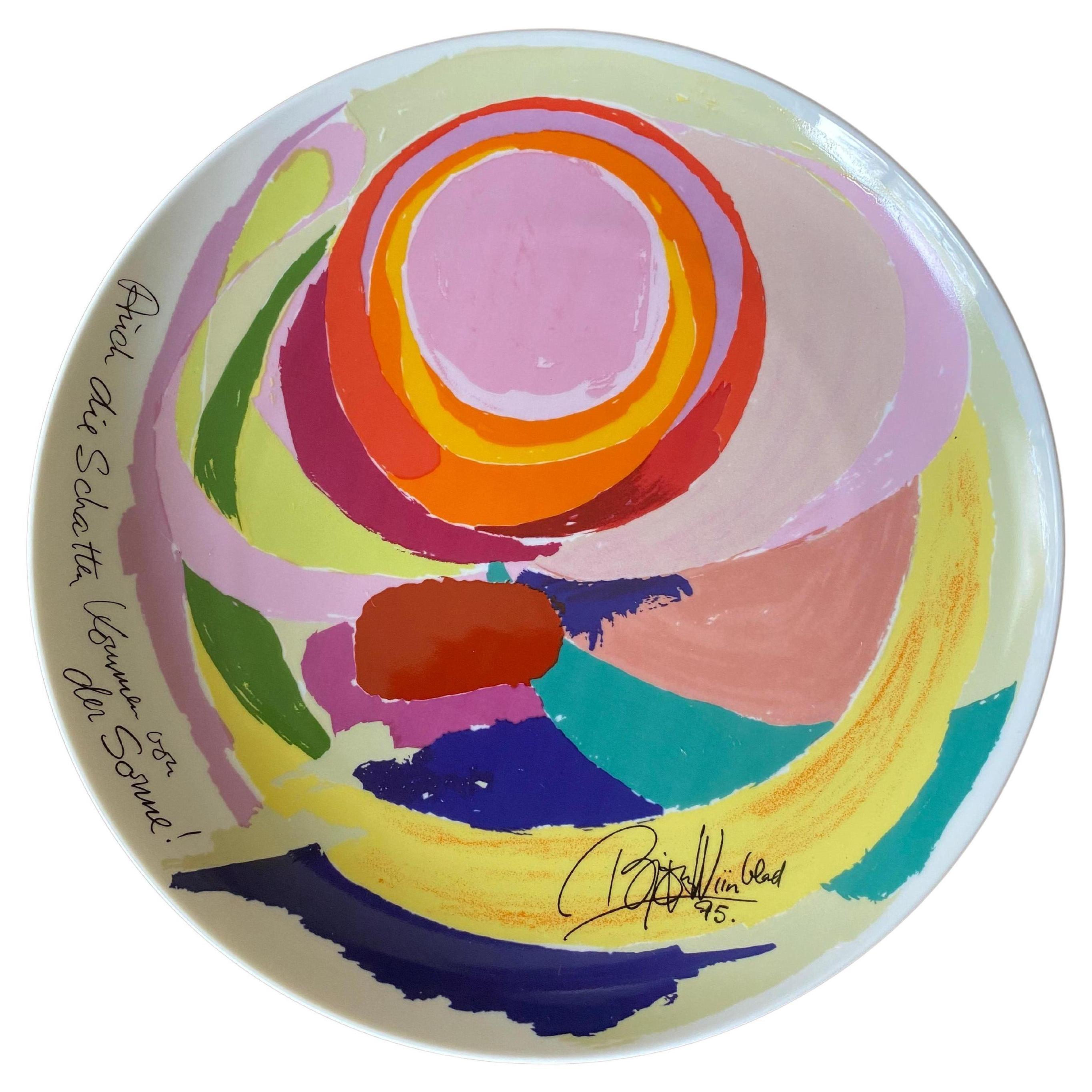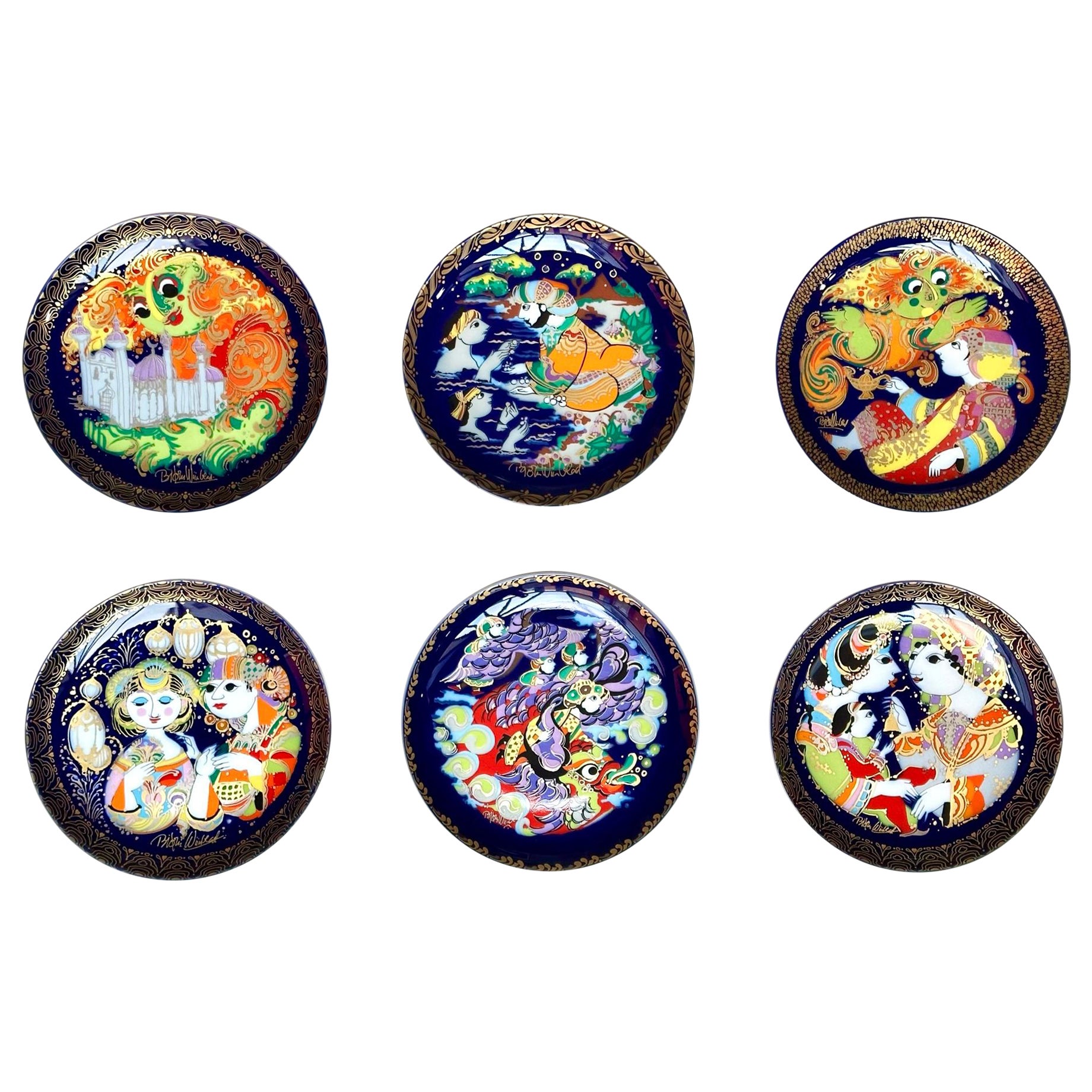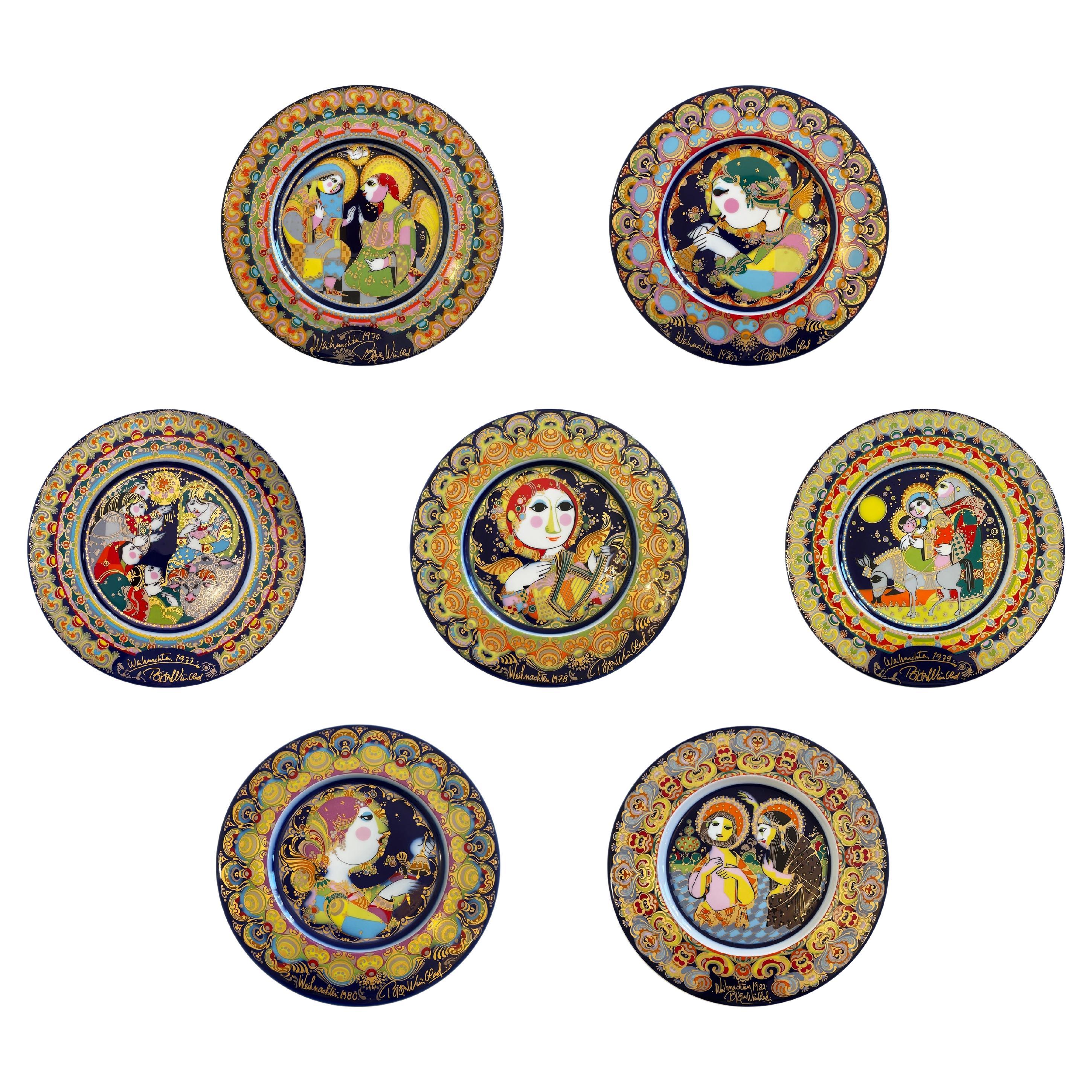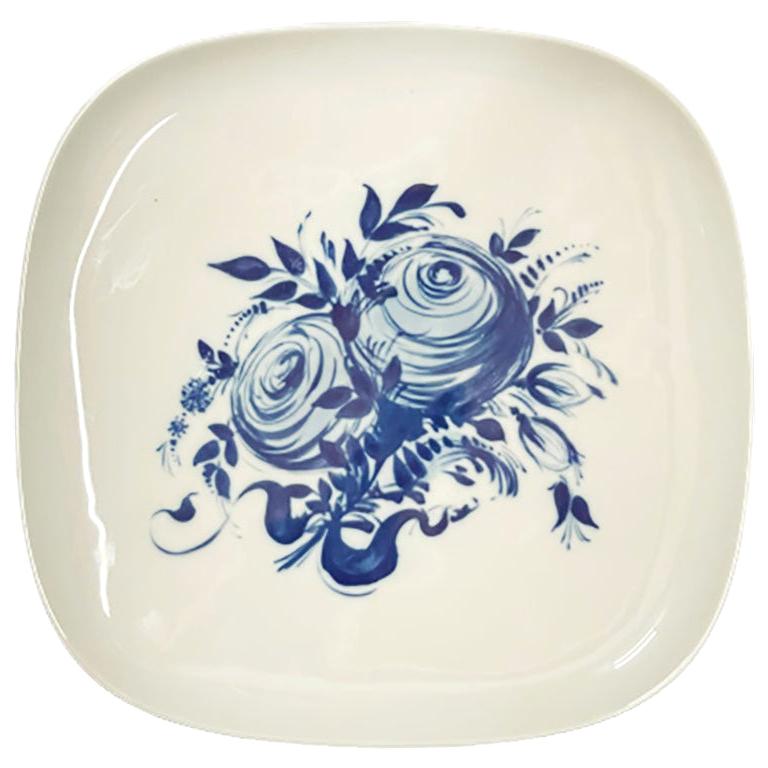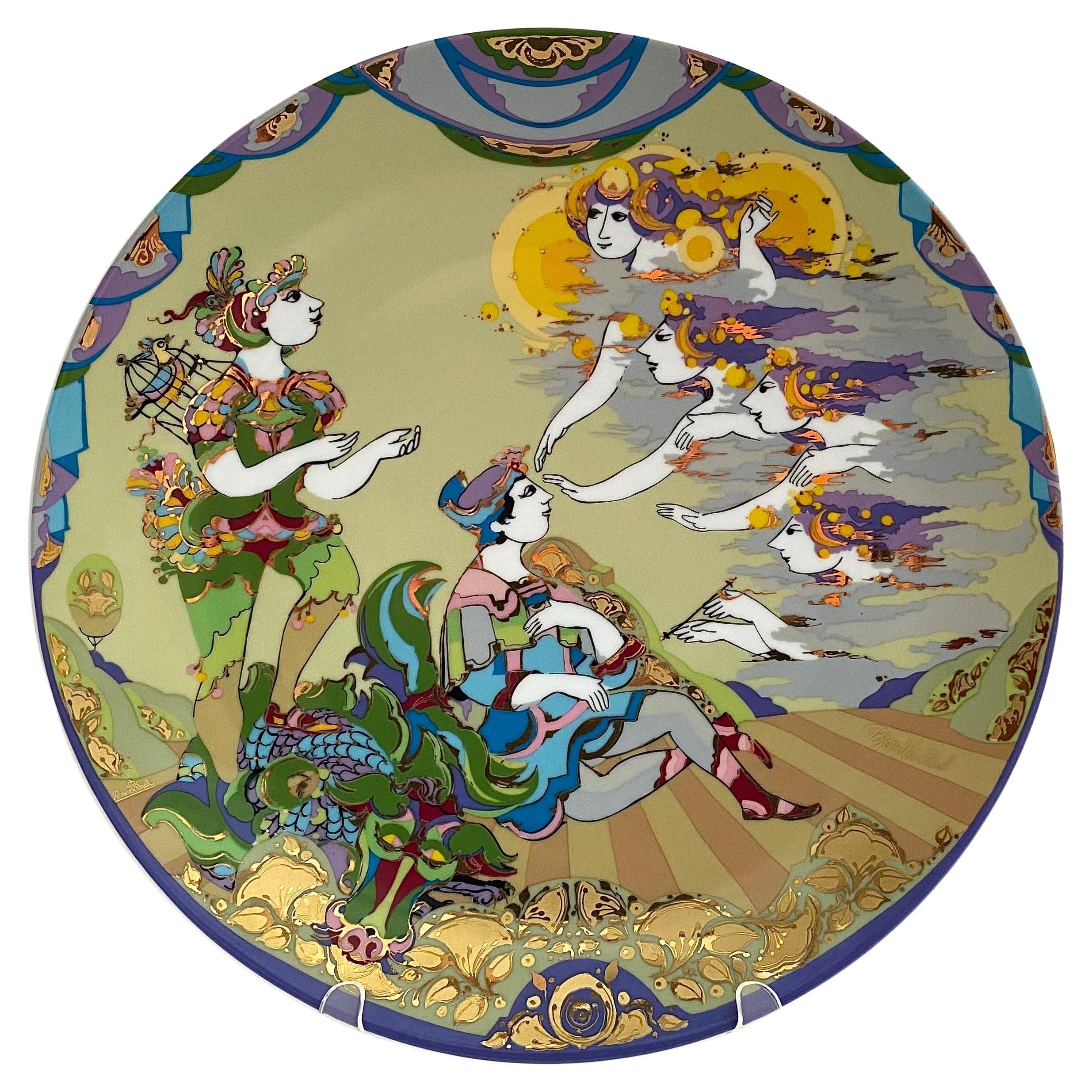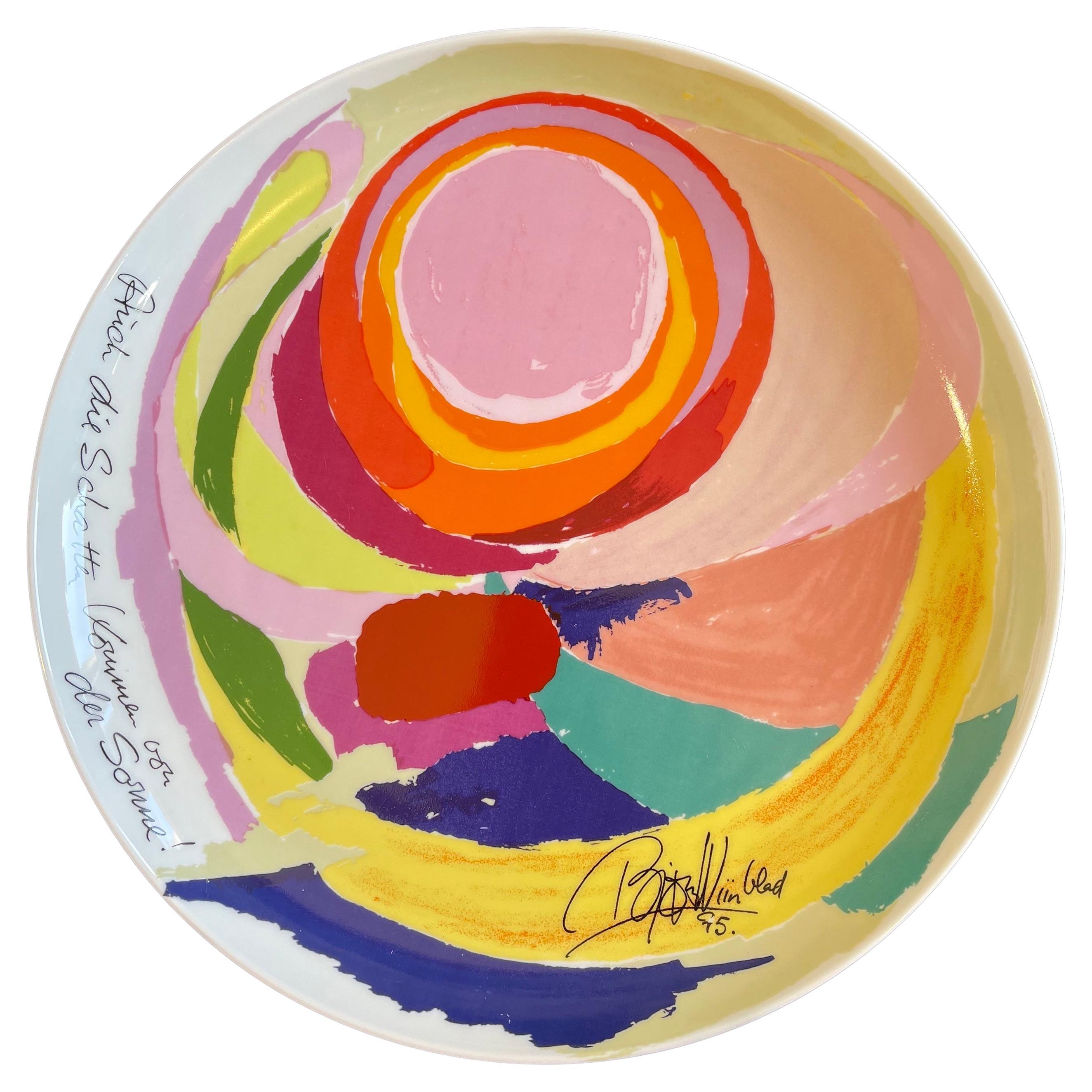Bjorn Wiinblad ALADIN in the Enchanted Garden Porcelain Plate by Rosenthal
About the Item
- Creator:Rosenthal (Manufacturer),Bjorn Wiinblad (Artist)
- Dimensions:Height: 0.75 in (1.91 cm)Diameter: 6.3 in (16.01 cm)
- Style:Expressionist (In the Style Of)
- Materials and Techniques:
- Place of Origin:
- Period:
- Date of Manufacture:1960
- Condition:Wear consistent with age and use.
- Seller Location:North Hollywood, CA
- Reference Number:
Rosenthal
While the Rosenthal Porcelain Factory grew from humble decorating roots — as many pottery companies do — it eventually built a list of universally revered designer and artist partners that included Andy Warhol and Salvador Dalí. And after securing an enviable position as a top manufacturer of serveware and dominating the porcelain and bone china markets, Rosenthal expanded into furniture production, working with influential designers Verner Panton, Luigi Colani and Günther Ferdinand Ris and Herbert Selldorf.
German-born Jewish businessman Philipp Rosenthal founded the company in 1879 in Bavaria. It began as his modest workshop where he painted porcelain and encountered success with porcelain ashtrays. Rosenthal hired the best designers and clay modelers he could find. Adolf Oppel designed figurative Art Nouveau pieces, while Eleonore (Lore) Friedrich-Gronau produced decorative objects, namely her graceful porcelain dancer figurines, for the company.
Dinnerware, though, would be a Rosenthal mainstay. Between 1904 and 1910, Rosenthal produced its renowned dinnerware lines such as Donatello, Darmstadt and Isolde. These were introduced as unornamented white pieces — only later were they given their underglaze designs.
Rosenthal founder Philipp, a Catholic of Jewish ancestry, resigned in 1934 as the company’s president due to pressures owing to discriminatory German laws that took shape during the rise of the Nazi regime. Rosenthal died in 1937, and the family fled to America. The company would not regain its footing until 1950 when Rosenthal’s son, Philip, joined the firm and, in 1958, became chairman and dubbed Germany’s “China King.” At its peak, the company had 10,000 employees.
In the 1950s, Rosenthal’s modernist dinnerware was a significant part of the brand’s offerings, and by 1961 they introduced the famed Rosenthal Studio Line. Although furniture designers and ceramicists would lead the list of individuals working with Rosenthal — among them Tapio Wirkkala, Max Weber and Lisa Larson — the company eventually reached out to fine artists, not only Dalí and Warhol but Sandro Chia and Kenny Scharf. Rosenthal also collaborated with fashion designers Gianni Versace and Donatella Versace.
In a daring move in 1972, the company diversified into furniture, collaborating with some of the giants of mid-century modern design. The revolutionary Sunball chair, an icon of Space Age seating crafted by Selldorf and Ris, was among Rosenthal’s stellar successes in this venture.
On 1stDibs, find vintage Rosenthal ceramics, porcelain, tableware, seating and more.
- ShippingRetrieving quote...Ships From: North Hollywood, CA
- Return PolicyA return for this item may be initiated within 7 days of delivery.
- Bjorn Wiinblad Christmas Plate Angel with Harp 1978 Collectible Limited Ed 11 inBy Rosenthal, Bjorn Wiinblad, Bjørn WiinbladLocated in North Hollywood, CABj0rn Wiinblad Christmas Plate 1978 "Angel with Harp". limited edition 11 inches diameter. Bjørn Wiinblad porcelain Christmas plate 1978, produced by Rosenthal. Dimensions: 11.25 in....Category
Late 20th Century German Baroque Ceramics
MaterialsPorcelain
- Rosenthal Collectible Framed Plates, Set of 3By RosenthalLocated in North Hollywood, CARosenthal collectible, set of three framed German plates. One by Vasarely, 1936. "Leben und Leben lassen, Liben und Lieben lassen" Limited edition, s...Category
Vintage 1980s German Modern Contemporary Art
MaterialsPorcelain
- Vintage Bjorn Wiinblad Tivoli Gardens Poster Copenhagen, Denmark, 1981By Bjørn Wiinblad, Bjorn WiinbladLocated in North Hollywood, CAVintage Bjorn Wiinblad Tivoli Gardens of Copenhagen, Denmark framed poster. Vintage poster printed by Permed & Rosengreen and designed by Bjorn Wiinblad depicting an harlequin advertising Tivoli Gardens in Copenhagen, Denmark, the colors are bold and vivid. Bjorn Wiinblad poster...Category
20th Century Danish Scandinavian Modern Posters
MaterialsPaper
- 1970s VASARELY "Live and let live love and let love" Rosenthal Framed PlateBy Victor Vasarely, RosenthalLocated in North Hollywood, CA1970s VICTOR VASARELY "Live and let live love and let love". Rosenthal collectible framed German plate. Victor Vasarely Rosenthal Studio Line Limited Edition Porcelain Plate. By Vasarely born 1936. "Leben und Leben lassen, Lieben und Lieben lassen" "Live and let live - love and let love". Limited edition, signed and numbered. Plate is in good condition, size is 12". Frame is not in good condition, white became yellowish shows wear. Victor Vasarely, born as Győző Vásárhelyi on April 9, 1906, in Pécs, Hungary, was a Hungarian-French artist widely regarded as the "father of Op Art" (Optical Art). He is known for his pioneering work in geometric abstraction and the use of optical illusions to create visually captivating and dynamic artworks. Vasarely's early career involved studying medicine in Budapest, but he later decided to pursue his passion for art and enrolled in the Műhely (Workshop) academy in Hungary. He initially experimented with various styles, including Impressionism and Post-Impressionism, but his interest in geometric abstraction grew stronger over time. In the 1930s, Vasarely moved to Paris, where he continued to explore geometric patterns, lines, and shapes in his art. He believed that art should not merely imitate nature but should create its own language of forms and colors to engage the viewer's perception actively. This philosophy led to the development of Op Art, a movement that emerged in the 1960s and focused on creating optical illusions and visual effects through precise geometric patterns and colors. Vasarely's artworks often featured meticulously arranged geometric shapes, giving the impression of movement and three-dimensionality. He employed various optical tricks, such as the juxtaposition of contrasting colors and the use of repetition, to create an illusion of depth and visual dynamism. His artworks can evoke a sense of visual vibration and often challenge the viewer's perception. Throughout his career, Vasarely's influence extended beyond the art world. He believed in the democratization of art and wanted to make art accessible to a wider audience. He embraced mass production techniques, creating what he called "multiple originals" or "serigraphs" (a form of screen printing). These serigraphs allowed him to produce multiple copies of his artworks at affordable prices, making them more accessible to art enthusiasts. Vasarely's artistic legacy continues to be celebrated around the world. His work has been exhibited in numerous galleries and museums, and he remains an influential figure in the fields of Op Art and abstract geometric art. He passed away on March 15, 1997, in Paris, leaving behind a vast body of work that continues to captivate audiences and inspire artists to this day. About Rosenthal: German porcelain manufactory Rosenthal was originally founded as a ceramics-painting studio by Philipp Rosenthal Sr. (1855-1937) in 1879 at Schloss Erkersreuth in Bavaria, near the Czech border. Its first highly popular product was an ashtray inscribed with the words “Resting place for lit cigars.” In 1890, the company moved to the neighboring hamlet of Selb and, a year later, began to manufacture its own porcelain, since white porcelain was, at that time, in short supply. Rosenthal’s first complete table service was called Empire; it was exhibited along with other lines at Paris’s Exposition Universelle in 1900. With the dawn of the 20th century, Rosenthal began producing porcelain tableware and services formed and decorated in the latest styles, like the Jugendstil Botticelli (1903), the Art Nouveau Darmstadt (1905), and the all-white Maria (1916) lines. Successes with this au courant approach led the company to launch an art pottery division in 1910, dedicated to luxury tableware, vases, and other decorative objects. By the 1930s, figurines were another important Rosenthal product, most notably the Disney-licensed Mickey Mouse pieces introduced in 1931. In 1934, Philipp Rosenthal was forced to leave his company and country when his Jewish ancestry came under persecution by the Nazi regime. Despite the loss of its founder, the Rosenthal company remained the premier supplier of high-quality porcelain tableware to the Third Reich. After the war, in 1950, Philip Rosenthal Jr. (1916-2001) joined his father's company as an advertising manager. By 1958, he had become its CEO, continuing his father’s vision to produce high-quality porcelain in line with progressive tastes. Through the rest of the 20th century, Rosenthal was the most commercially successful porcelain producer in Germany. In the postwar era, Rosenthal’s most famous tableware lines have included 2000 by Raymond Loewy and Richard Latham (1954), Magic Flute by Bjørn Wiinblad (1959), Suomi by Timo Sarpaneva (1976), and Moon by Jasper Morrison (1997). The company has enjoyed many popular and critically acclaimed collaborations with designers and brands, like Salvador Dalì, Tapio Wirkkala, Walter Gropius, Andy Warhol, Ron Arad, Enzo Mari, Konstantin Grcic, and Versace. Rosenthal's product lines have encompassed more than ceramics over the years. In 1972, the company began producing furniture, under the subsidiary Rosenthal Einrichtung, in Espelkamp, Germany. Standouts from this arm of Rosenthal include Gunter Ferdinand Ris and Herbert Selldorf’s futuristic Sunball Lounge Chair (1969), Verner Panton’s Relaxer Rocking Chair (1974), Burchard Vogtherr's Vario Pillo...Category
Late 20th Century German Post-Modern Decorative Art
MaterialsPorcelain
- JAMES RIZZI "City People" Rosenthal Germany Collectible Plate Limited EditionLocated in North Hollywood, CAJAMES RIZZI "City People" Rosenthal Germany Collectible Plate Limited Edition. 1970s Rosenthal collectible porcelain plate 'City People', designed by James Rizzi, Executed by Rosenthal, Germany, limited edition, no./1500 Limited edition, signed and numbered. Framed plate is in excellent condition, plate size is 12". Frames is not in good condition, white became yellowish shows wear. About James Rizzi: AMERICAN, 1950-2011 James Rizzi (October 5, 1950 – December 26, 2011) was an American pop artist who was born and raised in Brooklyn, New York. Best known for his vibrant, youthful graphics and his three-dimensional prints. He was the official artist for the 1996 Olympic Games in Atlanta, adorning the famous logo with his noodle-like drawing style. Rizzi was most famous for his 3D artwork, "especially the large, elaborate prints and teeming anthropomorphic cityscapes. His merry maximalism and delight in delirious detail and elaborate minutiae created a true art brand, a trademark style as recognizable as any in the world." About Rosenthal: German porcelain manufactory Rosenthal was originally founded as a ceramics-painting studio by Philipp Rosenthal Sr. (1855-1937) in 1879 at Schloss Erkersreuth in Bavaria, near the Czech border. Its first highly popular product was an ashtray inscribed with the words “Resting place for lit cigars.” In 1890, the company moved to the neighboring hamlet of Selb and, a year later, began to manufacture its own porcelain, since white porcelain was, at that time, in short supply. Rosenthal’s first complete table service was called Empire; it was exhibited along with other lines at Paris’s Exposition Universelle in 1900. With the dawn of the 20th century, Rosenthal began producing porcelain tableware and services formed and decorated in the latest styles, like the Jugendstil Botticelli (1903), the Art Nouveau Darmstadt (1905), and the all-white Maria (1916) lines. Successes with this au courant approach led the company to launch an art pottery division in 1910, dedicated to luxury tableware, vases, and other decorative objects. By the 1930s, figurines were another important Rosenthal product, most notably the Disney-licensed Mickey Mouse pieces introduced in 1931. In 1934, Philipp Rosenthal was forced to leave his company and country when his Jewish ancestry came under persecution by the Nazi regime. Despite the loss of its founder, the Rosenthal company remained the premier supplier of high-quality porcelain tableware to the Third Reich. After the war, in 1950, Philip Rosenthal Jr. (1916-2001) joined his father's company as an advertising manager. By 1958, he had become its CEO, continuing his father’s vision to produce high-quality porcelain in line with progressive tastes. Through the rest of the 20th century, Rosenthal was the most commercially successful porcelain producer in Germany. In the postwar era, Rosenthal’s most famous tableware lines have included 2000 by Raymond Loewy and Richard Latham (1954), Magic Flute by Bjørn Wiinblad (1959), Suomi by Timo Sarpaneva (1976), and Moon by Jasper Morrison (1997). The company has enjoyed many popular and critically acclaimed collaborations with designers and brands, like Salvador Dalì, Tapio Wirkkala, Walter Gropius, Andy Warhol, Ron Arad, Enzo Mari, Konstantin Grcic, and Versace. Rosenthal's product lines have encompassed more than ceramics over the years. In 1972, the company began producing furniture, under the subsidiary Rosenthal Einrichtung, in Espelkamp, Germany. Standouts from this arm of Rosenthal include Gunter Ferdinand Ris and Herbert Selldorf’s futuristic Sunball Lounge Chair (1969), Verner Panton’s Relaxer Rocking Chair (1974), Burchard Vogtherr's Vario Pillo...Category
Late 20th Century American Expressionist Decorative Art
MaterialsPorcelain
- Imari Japanese Asian Porcelain Wall Plates by Fabienne Jouvin, ParisBy Fabienne JouvinLocated in North Hollywood, CABeautiful designer decorative Imari Asian wall plates from the French Parisian designer Fabienne Jouvin. The plates with irregular shapes and quite shallow with a beautiful Oriental Asian Japanese style depicting a man and woman portrait on each plate. The portrait are period Imperial style, with Japanese kimono and hair style, vivid colors on each panel of the plate depicting different Asian traditional design motifs. Colorful modern Asian motif decorative plates or shallow bowls made by Fabienne Jouvin Paris...Category
Late 20th Century Chinese Japonisme Decorative Art
MaterialsPorcelain
- Rosenthal Studio Line Porcelain Plate by Björn Wiinblad 'Limited Edition'By Bjorn Wiinblad, RosenthalLocated in Waddinxveen, ZHStunning wall plaque by Bjorn Wiinblad for Rosenthal. The plaque was produced in 1975 in an edition of 5000, and this one is number 1328. The text on the plate is German ‘auch die...Category
Vintage 1970s German Mid-Century Modern Shelves and Wall Cabinets
MaterialsPorcelain
- Beautiful Collectible Plates Bjorn Wiinblad, Rosenthal, Germany, 1970sBy Rosenthal, Bjorn WiinbladLocated in Bastogne, BEBeautiful decorative plates designed by renowned Danish artist Bjorn Wiinblad for Rosenthal. Germany. 1970s. Porcelain plates from the end of the 20th century based on the fair...Category
Vintage 1970s German Decorative Art
MaterialsPorcelain
- 7 Hand Painted & Signed Bjørn Wiinblad Porcelain Plates for Rosenthal, 1970sBy Rosenthal, Bjørn WiinbladLocated in Andernach, DEBjorn Wiinblad, Danish artist, has created this beautiful series for German art glass & porcelain makers Rosenthal for their Studio-Line art edition. Plates from 1975 with the Annunc...Category
Late 20th Century German Mid-Century Modern Decorative Art
MaterialsPorcelain
- Rosenthal Porcelain Wall Plate by Bjorn Wiinblad, Germany, 1970sBy Bjorn Wiinblad, RosenthalLocated in Delft, NLRosenthal porcelain wall plate by Bjorn Wiinblad, Germany, 1970s Square wall plate with round finish, designed by Bjorn Wiinblad for Rosenthal,...Category
20th Century German Wall-mounted Sculptures
MaterialsPorcelain
- Plate Decorative Vintage Bjorn Wiinblad The Magic Flute Queen of the NightBy Bjorn Wiinblad, RosenthalLocated in Bastogne, BEThis amazing collector plate from Rosenthal Studio Line features a beautiful design inspired by Mozart's "The Magic Flute, First Act, Queen of the Night" (DIE ZAUBERFLOTE), by Danish...Category
Vintage 1970s German Decorative Art
MaterialsPorcelain
- Artist Plate No. 7 by Bjørn Wiinblad for Rosenthal, Mid-Century, 1970s GermanyBy Rosenthal, Bjørn WiinbladLocated in Andernach, DE''Auch die Schatten kommen von der Sonne'' (''Also the shadows are made by the sun'') – is the No. 7 of the ''Artists-Plates'' from the Studio-Line by Rosenthal. With a limited edi...Category
Mid-20th Century German Mid-Century Modern Decorative Art
MaterialsPorcelain
